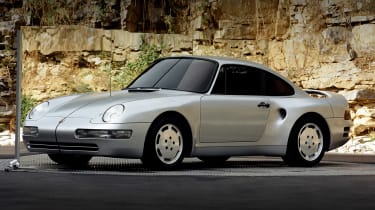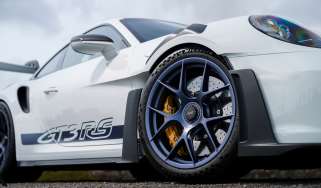Porsche 965 – Dead on arrival
In the second instalment of our series looking at evo cars that never made production, we spotlight a troubled 911 Turbo successor that fell victim to the late ’80s financial crisis

The Porsche 965 was conceived in the early ’80s as a standalone hero to replace the 911 Turbo and sit above the forthcoming 964 Carrera. Using lessons from the limited-run 959, it would feature an air-cooled, twin-turbo flat-six with water-cooled, four-valve heads, a four-wheel-drive transmission with the option of a double-clutch ’box, advanced adaptive air suspension, a floorpan shared with the 964 and a body that smoothly evolved the 959 look into a flagship for the ’90s.
The target output was 365bhp, enough for a top speed north of 190mph, and the price at launch in 1991 would have been around £75,000 – over 20 grand more than a Carrera 4. Expensive for a 911 spin-off, but not unreasonable for a car that would offer even more tech than its Group B forebear. To hammer home that this was a 959 and then some, in production form it would have been badged 969.
After sign-off in 1984, initial 965 development ran smoothly alongside the cheaper, simpler 964 sister car. But, as is often the way with doomed car projects, multiple factors began to weigh heavily on its genesis. The first issue was the 3.5-litre motor that, denied the racing tech that made the money-no-object 959 a 444bhp hero, fell short of the intended 365bhp to such a degree that engineers began to consider a broad range of alternatives, including a turbo V6 made from Hans Mezger’s Indy racing V8, and a brand new V8 to be shared with another doomed project of the day, the 989 saloon.
Unfortunately, in 1987 a bigger factor came into play as world markets crashed and Porsche, which had spent lavishly during the good times, correctly sensed that it was about to stop selling so many Guards Red 911s with pinstripe seats. An urgent programme of cost saving kicked in, culling less essential projects such as the 984 ‘Junior’ mid-engined roadster and the 928 cabrio.
The 965 survived, but sacrifices had to be made, starting with the engineers’ favoured solution to the power problem, which was to water-cool the entire flat-six. Since this nixed much of the cost saving from sharing parts with the 964, the new engine was put on the back burner and the 965 would now enter production with the existing 911 Turbo motor. This wouldn’t make anything like the intended bhp, but it would get the car on sale and water-cooled engine development would tick along in the background with the intention to fit it to the 965 when funds allowed.
Sadly, this belt-tightening wasn’t enough. During 1988 Porsche sales collapsed and the company was bleeding money, not least on the late-running, loss-making production of the 959. More cuts were needed, and the 965, with its engine now miles off target and its clever gearbox and suspension tech yet to be fully developed, was an obvious candidate for the chop. Newly installed development boss Ulrich Bez, later of Aston Martin, cast his eye over the cost and complexity of the 965 and saw little hope of profit on the other side. At the end of 1988 he gave the order for the project to be cancelled.
In its stead, Porsche initiated a hurried scheme to give the 964 a cost-effective Turbo variant using the old 930 motor, a model sometimes erroneously called 965 by Porsche perverts. The real 965 was wiped from the model plan and the 16 prototypes consigned to the scrapper. A single engineering car survived, however, and now lives in Porsche’s museum bearing a testament to the engine dilemmas that helped scupper the project: slung out behind its rear axle is an Audi V8.







